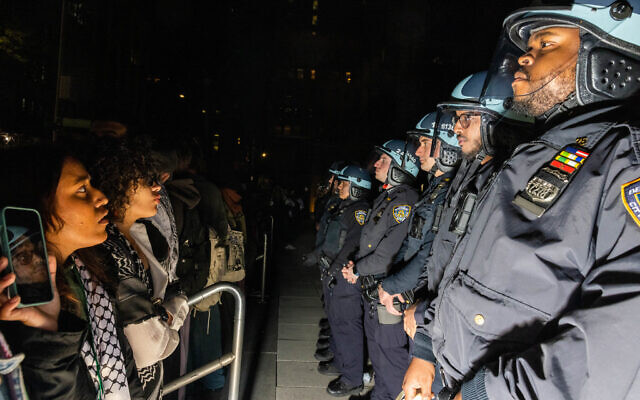American laws against ‘coloreds’ influenced Nazi racial planners
With neo-Nazis and white supremacists violently protesting in Charlottesville, Virginia, echoes of the country’s awkward history of ties to Nazism
 During the 1930s in Yaphank, New York, members of the Nazi party march through the Long Island town, where they also organized a pro-Hitler summer camp (Public domain)
During the 1930s in Yaphank, New York, members of the Nazi party march through the Long Island town, where they also organized a pro-Hitler summer camp (Public domain) White nationalists, neo-Nazis and members of the 'alt-right' clash with counter-protesters as they enter Lee Park during the 'Unite the Right' rally August 12, 2017 in Charlottesville, Virginia. (Chip Somodevilla/Getty Images/AFP)
White nationalists, neo-Nazis and members of the 'alt-right' clash with counter-protesters as they enter Lee Park during the 'Unite the Right' rally August 12, 2017 in Charlottesville, Virginia. (Chip Somodevilla/Getty Images/AFP) An example of racist political propaganda in the US, the kind of which Nazi racial planners looked to when formulating their own racial laws (Public domain)
An example of racist political propaganda in the US, the kind of which Nazi racial planners looked to when formulating their own racial laws (Public domain) Hundreds of white nationalists, neo-Nazis and members of the "alt-right" march down East Market Street toward Lee Park during the "Unite the Right" rally August 12, 2017 in Charlottesville, Virginia. (Chip Somodevilla/Getty Images/AFP)
Hundreds of white nationalists, neo-Nazis and members of the "alt-right" march down East Market Street toward Lee Park during the "Unite the Right" rally August 12, 2017 in Charlottesville, Virginia. (Chip Somodevilla/Getty Images/AFP) During the 1920s, members of the KKK march in Washington, DC (Public domain)
During the 1920s, members of the KKK march in Washington, DC (Public domain)
When a dozen right-wing extremist groups descended on Charlottesville, Virginia, over this weekend, members of the National Socialist Movement were among them, proudly displaying their swastika armbands and flags. Despite a relative absence from US history books, Nazis have deep roots in some parts of the country, and their efforts to alter the legal system against minorities once inspired Adolf Hitler.
The weekend’s nationalist protesters hail from a long line of homegrown Nazis, some of whom set up a network of pro-Hitler youth camps during American Nazism’s heyday. In addition to Nazi communities planting themselves in numerous states, other white supremacist groups, including the Silver Shirts and Friends of Progress, helped make Nazi ideology more prominent than ever during the 1930s.
Long before National Socialists set up shop in Yaphank, Long Island, their race-oriented predecessors helped turn American immigration law into an instrument of discrimination. To establish a restrictive entry system for Germany was a matter of course to Hitler, and his 1925 memoir was filled with admiration for America.
“The American Union categorically refuses the immigration of physically unhealthy elements, and simply excludes the immigration of certain races,” wrote Hitler in “Mein Kampf.”
Nazis were interested in how the US created ‘second-class citizenship’ for minority groups
Particularly in the American south — the former bastion of slavery — local measures against “colored” citizens were seen by the Nazis as a productive first step toward establishing Aryan supremacy. American jurisprudence with regard to racial “mixing” was also scrutinized, wrote James Q. Whitman in his book “Hitler’s American Model,” published earlier this year.
Contrary to myth, wrote Whitman, Hitler was not interested in what came to be known as Jim Crow-style segregation in the south. German society was already “mixed” by American standards, and the Nazis were more interested in how the US created “second-class citizenship” for minority groups, said Whitman.
“Early twentieth century America was the global leader in race law, admired around the world for the vigor of its legislation; in this the Nazis were not alone,” wrote Whitman, a professor of law at Yale University. “As in so many areas, this was one where American creativity shone.”
Hitler had an ‘admiring engagement’ with American’s handling of Native Americans
Hitler had an “admiring engagement” with America’s handling of Native Americans, said Whitman. In a 1928 speech, the future dictator said the US had “gunned down the millions of Redskins to a few hundred thousand, and now keeps the modest remnant under observation in a cage.”
For its policies toward Native Americans and attempts to keep the races apart, Hitler considered the US an admirable — but incomplete — example of a “volkisch” nation. A notable success, in Nazi eyes, was the “dead letter” citizenship afforded to blacks.

“It was not outlandish for [the Nazis] to think of their program of the early 1930s as a more thoroughgoing and rigorous realization of American approaches toward blacks, Asians, Native Americans, Filipinos, Puerto Ricans, and others — even if the regime had shifted its sights to a new target in the form of the Jews, even if it would later take the racist exercise of modern state power in an unimaginably horrifying new direction,” wrote Whitman.
‘Common law’ racism
In “Hitler’s American Model,” Whitman explained how the US has long been shaped by two forces: “formalistic liberal egalitarianism and realistic racism.” In other words, America remains racist in some ways, but strives toward enacting its better self.
“I expected angry responses, but by and large readers seem to have accepted the truth in what I found,” author Whitman told The Times of Israel in July. The professor of comparative law has written several books on criminal justice, and he’s particularly interested in the “widening divide” between the US and Europe.
The aspect of America’s “common law racism” that most appealed to the Nazis was called “anti-mongrelization law,” or measures aimed at preventing “mixed” marriages. In 30 states, “anti-miscegenation” laws existed to prevent these unions from taking place. There were even fines and jail sentences issued to offenders, something Whitman called “rare” in legal history.
Another aspect of American race law that appealed to Nazi legal minds was the ability of state and local judges to use common law to — for instance — discriminate against blacks. A Constitutional amendment might have freed the slaves, but many southern leaders, including governors, mayors and judges, were bent on denying blacks the voting rights afforded by citizenship.
Also of appeal to Nazi planners, US politics was “comparatively unencumbered by law,” and a plan like FDR’s “New Deal” could thrive in tandem with the country’s systemic racism, according to Whitman. This combination inspired the Nazis during the 1930s, when the “Four Year Plan” created new jobs and built a covert war machine, all while the persecution of Jews and other minorities steadily increased.
“What the American example showed was that German judges could persecute Jews even without legislation founded in clear and scientifically satisfactory definitions,” wrote Whitman. In a regime that was to become obsessed with “who is a Jew,” this flexibility — such as deployed by judges in the US south — would become important, including when the Nuremberg Laws were crafted.
As for comparisons to modern times, Whitman said he holds little hope “that the US will ever show much willingness to learn from foreign models,” he said about race relations.
“If Americans were willing, though, there are certainly things they could learn from contemporary Europe, and maybe from Germany in particular,” Whitman told The Times of Israel.
“That’s not because there are no problems with regard to race and immigration in Europe. Far from it. It has more to do with the Western European commitment to norms of human dignity, which stands in the way of the worst political abuses,” said Whitman, referring to what he views as the US and Europe’s diverging criminal justice systems.
Are you relying on The Times of Israel for accurate and timely coverage right now? If so, please join The Times of Israel Community. For as little as $6/month, you will:
- Support our independent journalists who are working around the clock;
- Read ToI with a clear, ads-free experience on our site, apps and emails; and
- Gain access to exclusive content shared only with the ToI Community, including exclusive webinars with our reporters and weekly letters from founding editor David Horovitz.

We’re really pleased that you’ve read X Times of Israel articles in the past month.
That’s why we started the Times of Israel eleven years ago - to provide discerning readers like you with must-read coverage of Israel and the Jewish world.
So now we have a request. Unlike other news outlets, we haven’t put up a paywall. But as the journalism we do is costly, we invite readers for whom The Times of Israel has become important to help support our work by joining The Times of Israel Community.
For as little as $6 a month you can help support our quality journalism while enjoying The Times of Israel AD-FREE, as well as accessing exclusive content available only to Times of Israel Community members.
Thank you,
David Horovitz, Founding Editor of The Times of Israel
- Jewish Times
- Nazis
- racism
- antisemitism
- University of Virginia
- white supremacists
- neo-Nazis
- terrorism
- white nationalism
- Holocaust
- Nuremberg Laws
- Jim Crow laws
- segregation
- General Robert E. Lee
- Confederate flag
- swastika
- Native Americans
- KKK Ku Klux Klan
- voting rights
- Black Americans
- immigrants
- law and justice
- Mein Kampf
- Yale University
- Third Reich
- immigration
- citizenship
- Europe
- US Constitution
- slavery
- Adolf Hitler
- Germany
- Donald Trump












